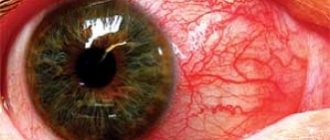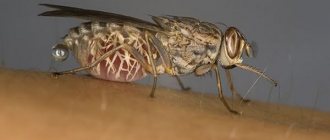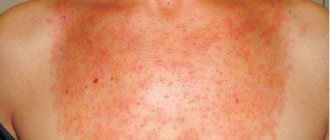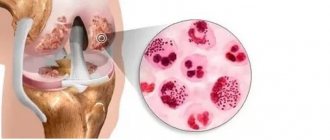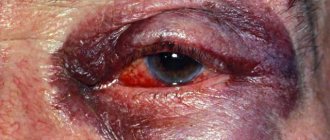| Vasculitis | |
| ICD-10 | 77.677.6, 80., 95., 30.-31. |
| ICD-9 | 446446, 447.6447.6 |
| DiseasesDB | 13750 |
| MeSH | D014657 |
Vasculitis
(Latin vasculum - vessel, -itis - suffix denoting inflammation), synonyms:
angiitis
(ancient Greek ἀγγεῖον - vessel),
arteritis
- this general definition combines a group of diseases based on immunopathological inflammation of blood vessels - arteries , arterioles, capillaries, venules and veins. As a rule, the consequence of this disease is a change in the structure and function of organs supplied with blood by inflamed vessels. The causes of the disease remain unknown. A combination of genetic predisposition with environmental factors, as well as infections involving Staphylococcus aureus or hepatitis virus, have been suggested[1].
Causes of vasculitis
The etiology of primary systemic vasculitis is unknown. However, several immunological mechanisms are thought to play a role in the pathogenesis of vasculitis, and each entity has its own characteristics.
Vasculitis - causes and pathological mechanisms:
- deposition of immune complexes on the walls of blood vessels;
- autoantibodies (eg, antiendothelial antibodies and ANCA);
- cellular and molecular immune responses;
- granuloma formation;
- damage to endothelial cells.
CD4 + T cell polarization of the immune system is generally involved in almost all pathogenic vasculitic mechanisms.
These mechanisms include a Th1 response involving T cells and macrophages secreting large amounts of interferon (IFN) γ, a Th2 response involving B cells, and secretion of cytokines (eg, interleukin (IL)-4, IL-5, and IL-10 ), and the production of autoantibodies.
In addition, the recently described Th17 polarization is involved in the pathogenesis of vasculitis as a factor in vascular inflammation.
All pathogenic processes lead to inflammation, damage and necrosis in the vessel wall, which leads to the manifestations of vasculitic syndromes
What do doctors predict?
When vascular tissues die, internal bleeding occurs, regardless of the size of the vessel. This can lead to serious pathologies of any organs, brain, and even death.
Predicting the future condition depends on several factors:
- The extent of damage by inflammation of the walls of blood vessels;
- Concomitance with other diseases;
- The immune response of each person;
- Pathological deviations that have already occurred.
If vasculitis is detected early, effective therapy will help achieve remission of the skin rash. Inflammation in the kidneys and brain, accompanied by intellectual and physical abnormalities, is predicted to be less favorable.
If attacks of the cutaneous form of vasculitis often recur, the musculoskeletal system may be irreversibly impaired. In this case, the prognosis is less favorable, and the patient must undergo a course of therapy to maintain the vessels in working condition. During therapy, constant supervision by a therapist is necessary.
The consequences can depend on many reasons, and prediction is made in each individual situation individually. Lethal outcomes are possible in advanced forms and in provoking the development of pathologies and hemorrhages in other organs.
If you notice any symptoms, do not hesitate and seek help from qualified doctors. Self-medication can lead to advanced complications and pathologies. The sooner vasculitis is diagnosed and effective therapy is prescribed, the faster a favorable outcome can be achieved. Do not self-medicate and be healthy!
Classification
The classification currently used for the Vasculitis group of diseases was developed at the international consensus conference of the CHCC in 2012 and was approved by the European Society of Pediatric Rheumatology (PRES) and the European League Against Rheumatism (EULAR). These criteria are an adaptation of the existing American College of Rheumatology criteria for vasculitis in adults.
There are about 20 different disorders that are defined as "Vasculitis".
Although these diseases are similar in some ways, they differ greatly depending on which organs are affected, what medications are used to treat them, etc.
Main types of vasculitis
Behçet's disease is characterized by a triad of ulcerative lesions of the mouth, eyes and genitals. Other organ systems may also be affected.
Buerger's disease (Thromboangiitis obliterans) - mainly affects smokers and leads to decreased blood flow to the arms and legs.
Kawasaki disease is a necrotizing vasculitis, which is based on superantigen-mediated activation of lymphocytes against the background of provoking the process by infectious agents.
Eosinophilic granulomatosis with polyangiitis (EGPA, formerly Churg-Strauss disease), is associated with asthma, nasal polyps, sinusitis, and increased eosinophil counts. EGPA tends to affect the lungs, peripheral nerves, skin, kidneys, and heart.
Cryoglobulinemia is characterized by recurrent purpura (red spots) on the lower extremities and is associated with hepatitis C virus or paraproteinemias.
Giant cell arteritis—formerly called temporal arteritis—affects people over 50 years of age (though most affected people are between 70 and 80 years old). It is characterized by fever, headache, jaw/scalp pain.
Thrombocytopenic Henoch-Schönlein purpura is a disorder that is often precipitated by upper respiratory tract infections and is often, but not necessarily, self-limiting.
Microscopic polyangiitis is a systemic vasculitis affecting small and medium-sized blood vessels and is associated with ANCA autoantibodies.
Polyarteritis nodosa is a variant of systemic vasculitis that involves many different organ systems and is concentrated in medium-sized arteries.
Polymyalgia rheumatica is a syndrome of pain and stiffness localized to the shoulders and hips that often occurs in association with giant cell arteritis.
Rheumatoid vasculitis is a condition that sometimes complicates the course of rheumatoid arthritis. Usually occurs in patients with a severe form of the underlying disease.
Takayasu arteritis is a large vessel vasculitis that affects the aorta, its main branches to the extremities, and sometimes the internal organs. Typically occurs in young women (<50 years of age).
Granulomatosis with polyangiitis (GPA, formerly Wegener's granulomatosis) is a systemic disease that affects the lungs, kidneys, upper respiratory tract, and other organs. Associated with ANCA autoantibodies.
Diagnostics
Most of the procedures used during the examination and treatment of a patient with vasculitis are carried out in the diagnosis and treatment of other diseases, so they are not specific to vasculitis. However, without them, a reliable and accurate diagnosis of vascular inflammation is impossible.
During the examination of the patient, various modern methods are used.
- Angiography.
This method evaluates the structure and passage of blood vessels, resulting in the identification of blockages, inflammation or other abnormalities. There are many ways to perform angiography. Ultrasound is most often used to examine large vessels without the use of X-rays or dyes. Magnetic resonance imaging (MRI) uses a magnetic field to create detailed images of certain blood vessels and, if necessary, can be combined with special dyes (contrast agents) given by injection to the patient. Computed tomography (CT), which uses X-rays, evaluates the structure of blood vessels. It is usually performed using contrast dyes. A positron emission tomography (PET) scan requires an injection of radioactive drugs and can be helpful in identifying where blood vessels are inflamed.
- Abdominal ultrasound examination.
It is based on the use of sound waves, with the help of which a picture of the organs and anatomical structures located in the abdomen is created. This test can show whether there are abnormalities in the abdominal cavity.
- Biopsy.
During the procedure, a small piece of tissue is removed from the affected area or organ, such as the skin or kidney. The tissue is then examined under a microscope by a pathologist. If necessary, special tests may be performed to identify disease affecting the organ.
- Bronchoscopy.
A procedure during which the doctor examines the patient's respiratory tract (trachea and bronchi). The purpose of the study is to determine the area of damage, and biological samples may also be collected for biopsy or washing. This allows you to clarify the cause of the disease, especially if it developed due to infection. The trachea and bronchi are the main tubes that carry air to the lungs. Typically a fiberoptic bronchoscope (thin, flexible, with a telescope at the end) is used.
- DEXA scan.
Also known as dual-energy X-ray absorptiometry. This is a test that measures bone density. Can be used to identify or monitor bone strength, especially in long-term patients treated with steroid drugs.
- Electrocardiogram.
A simple and painless diagnostic method for recording the electrical activity of the heart. Often provides useful information about the condition of the heart and can provide information on whether an organ is associated with vasculitis.
- Spirometry.
Refers to pulmonary function tests. The volume of the lungs, the amount of air inhaled and exhaled, and how well the transfer of oxygen from the lungs to the blood occurs is determined. This may be useful for monitoring patients whose lungs or airways have been affected by vasculitis.
- Tracheostomy.
Tracheostomy is sometimes necessary for patients whose main airway is blocked or narrowed as a result of damage caused by vasculitis. This provides direct access to the trachea by making a surgical opening in the anterior neck. This allows air to flow directly into the lungs, allowing patients to breathe properly when their upper airways are blocked.
Tracheostomy may be a temporary measure, especially for patients who have severe vasculitis. It can also be used permanently if irreversible changes have occurred in the body. For patients with a permanent tracheostomy, a special tube is inserted to hold the opening open and allow normal speech. This allows you to live a more or less normal life.
- Electromyography.
Electrical stimulation of muscles (usually in the arms or legs) is assessed to look for evidence of abnormal muscle function, such as in vasculitis. Often the test is performed in combination with a nerve conduction study.
- Echocardiography.
An ultrasound test that uses sound waves to create images of the heart. The test reveals the size and shape of the heart, as well as the order in which the chambers and valves work.
- Computed tomography (CT).
Provides more detailed information about internal organs than conventional radiography (X-ray).
- Positive emission tomography.
The test is also known as a PET scan. During this procedure, three-dimensional images are taken that show the level of metabolic activity, which is an indicator of inflammation.
- Analysis of urine.
A simple but very important urine quality test identifies abnormal levels of protein or blood cells in the urine. If such signs are detected, then kidney damage is diagnosed.
Symptoms of vasculitis
Systemic vasculitis is a heterogeneous disease that affects different organs and systems with varying degrees of severity depending on the size, location and extent of the vessels affected. Symptoms can range from subacute nonspecific complaints to life-threatening manifestations, such as alveolar hemorrhage and acute renal failure.
With a diagnosis such as vasculitis, symptoms are usually divided according to the affected organs and systems.
- Constitutional symptoms are fever, weight loss, fatigue, malaise. Occurs in 90-100% of patients with granulomatosis with polyangiitis GPA (formerly Wegener's granulomatosis) and microscopic polyangiitis MPA.
- Skin - painful nodular or erythematous rash, ulcerations, purpura, petechiae, papulopustular lesions, Raynaud's phenomenon, edema of the lower extremities, etc.
- Recurrent ulcers in the mouth and/or genitals that heal with scarring.
- Allergic rhinitis, nasal congestion, recurrent epistaxis, sinus pain, lacrimation
- Pulmonary - chronic cough, hemoptysis, shortness of breath, stridor, chest pain.
- Musculoskeletal system - joint pain or swelling, myalgia.
- Kidneys - hematuria, hypertension
- Gastrointestinal tract - abdominal pain, hemoptysis, vomiting, nausea
- Vascular - intermittent claudication, blood pressure difference between limbs, syncope
- Neurological - headache, seizures, focal neurological impairment (stroke, cranial nerve palsy, vision loss, minor motor impairment, movement abnormalities), diffuse neurological deficit (decrease in cognitive abilities, poor school performance), mononeuropathy or polyneuropathy (numbness, paresthesia, dropped arm/leg, weakness), visual/auditory hallucinations, hesitation/decreased level of consciousness/encephalopathy
The manifestations of the most significant vasculitis in clinical practice—Kawasaki disease and Henoch-Schönlein purpura—are discussed separately.
Clinical signs characteristic of Henoch-Schönlein purpura:
- a noticeable purple rash (must be present);
- diffuse abdominal pain;
- arthritis (acute, any joint) or arthralgia;
- hematuria and/or proteinuria;
- swelling of the lower limb.
Clinical signs common to Kawasaki disease:
- fever for at least 5 days not responding to antibiotic therapy;
- polymorphic exanthema (non-vesicular);
- desquamation of the perineum;
- changes in the skin of the extremities (erythema and/or swelling);
- lymphadenopathy, usually unilateral, greater than 1.5 cm;
- bilateral, non-purulent, conjunctivitis;
- changes in the lips and oral cavity - injection of the mucous membrane of the oral cavity and pharynx; cracks in the lips;
- irritability, arthralgia/arthritis.
Such a variety of symptoms leads to the fact that if vasculitis is suspected, diagnosis is very difficult. The diagnosis is made after a comprehensive examination, including many tests for specific antibodies, biochemical blood parameters, autoimmune markers, and also after a mandatory biopsy.
Treatment of vasculitis
With a diagnosis such as vasculitis, treatment should take place with the participation of an interdisciplinary team of specialists (rheumatologists, cardiologists, nephrologists). Patients require long-term follow-up to monitor relapses, disease activity, end-organ damage, and treatment-related morbidity.
Treatment of children with Kawasaki disease includes hospitalization with mandatory therapy with intravenous immunoglobulin (IVIG) and high-dose aspirin in the acute phase of the disease.
IVIG-resistant disease can be treated with methylprednisolone and/or other immunosuppressive agents.
Infliximab and adalimumab can be considered as first-line immunomodulatory drugs for the treatment of ocular manifestations of Behçet's disease.
In general, adult patients with ANCA vasculitis are treated according to varying levels of severity. To help decide on treatment tactics, the European Vasculitis Study (EUVAS) group proposed a method for assessing the severity of manifestations.
Optimal induction therapy for patients with generalized disease (renal or other major organ involvement) remains the subject of intensive study. Initial recommendations suggested a combination of cyclophosphamide and high-dose glucocorticoids. However, there have been three studies examining the use of rituximab as an induction agent in adults with granulomatosis polyangiitis (GPA) and microscopic polyangiitis (MPA). These studies showed that rituximab was as effective as cyclophosphamide in inducing remission.
Treatment of vasculitis in Belgium
General principles and approaches
Targeted therapy based on monoclonal antibodies has become a landmark achievement in the treatment of vasculitis. They are specifically targeted against specific types of lymphocytes or inflammatory/immune molecules.
Recent treatment guidelines suggest that rituximab may be preferred when avoidance of cyclophosphamide is desired (eg, due to toxicity).
A study conducted at the Leuven Clinic by Professor Van Daalen et al showed that treatment with rituximab for ANCA-associated vasculitis had a lower risk of malignancy than treatment with cyclophosphamide, and that rituximab was not associated with an increased risk of malignancy compared with general population.
Local recommendations for the prevention of glucocorticoid-induced osteoporosis should be followed in all patients. Use of cyclophosphamide should be limited to 3-6 months due to potential long-term toxicity.
Plasmapheresis is used as an additional therapy for patients with rapidly progressing severe kidney disease in Belgian clinics.
Maintenance therapy
Available evidence suggests that once remission is achieved using a cyclophosphamide- or rituximab-based regimen, maintenance therapy is necessary to prevent relapse. One alternative has been the use of methotrexate or azathioprine.
A recent study also suggested the use of a two-year course of rituximab as maintenance therapy. It is also recommended to use low doses of glucocorticoids (10 mg/day prednisone). Maintenance therapy should continue for at least 18–24 months, and early discontinuation is associated with an increased risk of relapse.
Refractory or relapsing disease
The randomized, controlled, double-blind RAVE trial found that rituximab was particularly effective in this population. Several other small series also report the effectiveness of rituximab in patients with refractory or relapsed disease. Other options for refractory or relapsed disease include IVIG, mycophenolate mofetil, infliximab , 15-deoxyspergualin, and antithymocyte globulin.
Systemic polyarteritis nodosa
Patients with severe disease should receive a combination of cyclophosphamide and glucocorticoids. However, a selected group of patients with mild polyarteritis nodosa can be successfully treated with glucocorticoids alone.
Cutaneous polyarteritis nodosa
Some patients respond to NSAIDs alone. However, most require treatment with prednisone. For long-term treatment, steroid-sparing agents are used (for example, methotrexate, mycophenolate mofetil , IVIG).
Large vessel vasculitis
There is a lack of large controlled studies in the treatment of large vessel vasculitis, even in adult patients. Recommendations for its treatment in Belgian clinics are based on EUVAS recommendations.
Azathioprine or methotrexate is used as an adjunct to steroid therapy in patients with Takayasu's arteritis to improve disease control and to reduce steroid dosage. Cyclophosphamide has been used in adults with glucocorticoid-resistant Takayasu arteritis.
In addition, tumor necrosis factor (TNF)-α inhibitors (eg, infliximab, etanercept) have been tried with encouraging results, including in a small study of 4 children.
Primary vasculitis of the central nervous system
Treatment begins with high-dose steroids and monthly intravenous cyclophosphamide for 6 months, followed by mycophenolate mofetil or azathioprine for 18 months. Antithrombotic therapy (heparin, then an antiplatelet agent) may be added for large vessel disease.
Surgical assistance
When the aorta and renal arteries are involved, angioplasty and stenting of stenotic vessels are used to improve blood flow (eg, Takayasu arteritis). A significant proportion of vessels may develop restenosis, but there is a good response to a repeat procedure. In addition, reconstructive surgery with graft implantation may be required.
It is important that vascular procedures should be performed during periods of inactive disease.
Patients with Wegener's granulomatosis may develop subglottic stenosis. This condition requires endoscopic treatment with local administration of a corticosteroid and/or the use of mitomycin-C. Also, in granulomatosis with polyangiitis (formerly Wegener's granulomatosis), repeat procedures are often necessary, and some patients may require a tracheostomy.
Therapy methods
Many people do not understand who treats this disease, who needs to be contacted first. At the first signs of the disease, of course, you should consult a therapist, then you will need the help of a cardiologist, ophthalmologist, dermatologist, or neurologist. The direct treatment is carried out by a rheumatologist.
If this diagnosis is made, then you will have to be treated and observed by a specialist for the rest of your life. The sooner the patient consults a doctor, the greater the chance of stopping the progression of the disease. Vasculitis should be treated based on the following principle:
- First, it is necessary to determine the factor that led to the development of the disease, and if necessary, discontinue the drug that caused vasculitis.
- Carrying out therapeutic actions.
- If necessary, carry out methods for blood purification.
Drug therapy
To help the patient, doctors prescribe the following medications:
- Anti-inflammatory hormonal drugs, as a rule, are: Prednisolone, Dexamethasone, Triamcinolone.
- Heparin, which is administered subcutaneously, is necessary to control blood clotting.
- Curantil is recommended as a preventive measure for bleeding.
Anti-inflammatory drugs reduce swelling, itching, and reduce the number of rashes, for example, Ortofen, Piroxicam.
- Antihistamines help relieve swelling and itching. For these purposes, Zyrtec, Zodak, Tavegil, Suprastin are prescribed.
- To maintain the body, multivitamin preparations are prescribed, for example, Vitrum, Aevit, Duovit, Biovital.
- Immunosuppressants are prescribed in cases of rapidly developing disease. These are drugs such as: Cyclophosphamide, Azathioprine.
- To eliminate toxins, it is recommended to take Activated Carbon, Polyphepan.
- Immunostimulants relieve signs of the disease, for example, Cycloferon, Grippferon, Viferon, Anaferon, Arbidol.
Local therapy
Local preparations help maintain the strength and elasticity of the skin, restore vascular tone, and improve blood circulation.
Most often, doctors prescribe:
- Methyluracil - promotes recovery and relieves inflammation.
- Acemina - helps cleanse the lesion from exudate, accelerates tissue regeneration.
- Iruksol - relieves inflammation and kills pathogenic substances.
- Troxevasin - has an anti-inflammatory effect, improves the condition of blood vessels.
Traditional medicine methods
Traditional recipes are often used in combination with traditional medicine methods. The most effective methods are listed below:
- take 60 g each of horsetail and elderberry, add 40 g each of mint and yarrow. Pour 4 tablespoons of herbal mixture with ½ liter. boiling water, bring to a boil, leave for 12 hours. Take ½ cup three times. To improve the effect, you can make applications with this infusion, leaving them on the affected area for 30 minutes;
- take equal quantities of calendula, arnica, sophora. Pour 2 tablespoons of herbal mixture into 1 glass of boiling water, leave for 3 hours, strain, drink this infusion the day before;
- 1 cup of birch buds, previously ground to powder, mixed with 1 kg of lard, put in a clay dish, and put in the oven for 3 hours. Simmer in the oven for a week for 3 hours daily. Apply ointment to the affected area.
Vasculitis is a serious disease that requires prompt treatment to help avoid complications.
DO YOU STILL THINK THAT IT IS IMPOSSIBLE TO GET RID OF VARICOSE VARICOSIS!?
Complications
Complications of vasculitis depend on the type and severity of the condition. Or they are related to side effects of prescription medications used to treat the condition.
- Direct organ damage. Some types of vasculitis are severe, causing damage to vital organs such as the kidneys or lungs.
- Blood clots and aneurysms. A blood clot can form in a blood vessel, obstructing blood flow, which can ultimately lead to strokes, heart attacks, or pulmonary embolism (PE). In rare cases, vasculitis causes a blood vessel to weaken and bulge, forming an aneurysm.
- Loss of vision or blindness. This is a complication of untreated giant cell arteritis.
- Infections. These include serious and life-threatening conditions such as pneumonia and blood poisoning (sepsis).
Prevention
Measures to prevent cutaneous vasculitis are:
- timely diagnosis and treatment of vascular diseases;
- immediate discontinuation of all medications that the patient takes on his own;
- limiting all types of radiation (UV irradiation, sun exposure, X-rays, isotopes);
- changing working conditions to more comfortable ones without temperature changes, prolonged standing, or hypothermia;
- getting rid of bad habits;
- following a diet to strengthen capillaries and vessel walls;
- eliminating possible allergens.
Cutaneous vasculitis is a very insidious disease.
The exact reasons for its occurrence have not yet been identified. It is known that pathology, in the absence of therapy, destroys the human circulatory system, provoking irreversible changes in the body.

